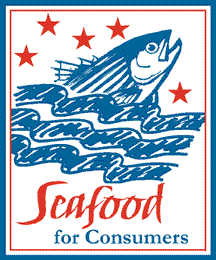
Number 7
June 20, 1999

 |
 |

Of dogfish and overfishing and productive capacity
Out of the many thousands of species of fish and shellfish found in the coastal and offshore waters off the mid-Atlantic and New England, perhaps three or four dozen are primary targets of commercial and recreational fishermen. Of these, perhaps a third occupy what biologists would consider similar niches. Simply stated, this means those species inhabit the same general areas during approxinately the same seasons and feed on the same or similar organisms. These species could be considered to be in competition with each other; in competition for food and in competition for space.
One of the few more-or-less stable characteristics of a given area of ocean or estuary is its productive capacity; that is, its ability to produce a given mass of plants and animals. This productive capacity is determined by the amount of sunlight - the ultimate energy source for most of the world’s oceans - incident on the water surface and the nutrients available in the water column (or actually, the maximum availability of whichever nutrients are most limiting). Obviously - barring minor fluctuations due to weather/climate - the amount of sunlight remains constant. So if we assume constancy in the nutrient input (equally obviously, not always a given), the amount of plant and animal material produced by a particular area of ocean is going to remain about the same from year to year. But the form that production will take - the species and size composition - can and does vary significantly.
With those species that occupy the same or similar niches, it’s safe to say that there’s some interchangeability between species, but the total production of all of them from a given area will be about the same year after year.
The case with dogfish -
Not too many years ago dogfish were considered an underutilized species. This meant there were a lot of them in the U.S. Exclusive Economic Zone, there was very little fishing pressure on them, and there were existing or developable markets for them. Realizing this, and realizing as well that there was too much fishing pressure on many of the traditional species in the same areas off the Mid-Atlantic and New England states, the federal government started to encourage the harvest and sale of dogfish. Incentives of various sorts were provided to get fish and seafood businesses involved in catching, processing and selling them. As a result a number of U.S. fishermen, docks, processors and exporters (the domestic market for dogfish was and still is very limited) got seriously into the dogfish business.
As the build-up of the dogfish business - dependent, of course, on the eventual high level of landings of dogfish - continued it appeared as if the management establishment had forgotten about the fishery. More and more boats, many of them moving from other so-called “overcapitalized” fisheries, fishing more and more gear came into the fishery. Processing capacity and overseas markets expanded to keep up with the increased landings.
And then two or so years ago the managerment establishment decided - with some nudging by Congress via the Sustainable Fisheries Act and a great deal of concern expressed by some anti-fishing groups - that it was time to start managing this only recently underutilized fishery. So, after the requisite number of meetings, public hearings, etc., it was determined that dogfish were being seriously overfished and that, starting sometime in 1999, the directed fishery for dogfish would be completely shut down. All of the fishermen, docks, processors and exporters who had, at the urging and with the support of their government via the U.S. Department of Commerce’s National Marine Fisheries Service, invested time and money into the dogfish fishery were all of a sudden to be kicked out of the fishery.
A sad story for the businesses involved. But one, our conservation-minded colleagues might argue, that will have a happy ending because the overfished dogfish stocks will now be allowed to recover. And, after all, what would the oceans be without dogfish?
But how likely was it that we were going to run out of dogfish?
Several times a year the National Marine Fisheries Service conducts trawl surveys of the waters offshore of the mid-Atlantic and New England states to determine the relative abundance of particular species of fish and shellfish. Looking at the report from NMFS’s most recent spring bottom trawl survey, that conducted by the R/V Albatross from March 1 to April 22, 1999 (from the “Fishermen’s Report” of this survey), we see that over that time period 329 sample tows of 1/2 hour duration using modified commercial fishing gear were made in the waters from the Maine to Cape Hatteras. In the words of the report, “Because of the 30 minute tow duration, and random selection of station locations, catches can be light compared with commercial tows.... Nevertheless, these data can provide fishermen with useful information about the distribution and realtive abundance of species inhabiting the survey area (Cape Hatteras to the Gulf of Maine).” Considering the fact that the economic rug is in the process of being pulled out from under all of those businesses that have invested so recently in the dogfish fishery, one would be justified in expecting the abundance of dogfish to be quite low relative to the other species sampled in this survey. But are they?
How many dogfish are out there?
According to the data provided in the report and reproduced below, over
40% by weight of all of the fish caught in the March/April bottom trawl
survey this year were dogfish, and the tows in which dogfish were caught
weren’t concentrated in one or several areas, they were spread out over
the entire area sampled. Throughout the entire range of the survey over
one pound of dogfish was caught for every pound and a half of other fish
species. And they were caught in well over half of the areas sampled. One
hesitates to think how many dogfish there would be in the ocean if they
weren’t being so heavily overfished as to justify closing down the fishery.
| Species | Lbs. | % |
| Spiny dogfish | 36434 | 41.50% |
| Winter skate | 2687 | 3.10% |
| Little skate | 13095 | 14.90% |
| Atlantic herring | 5006 | 5.70% |
| Silver hake | 1243 | 1.40% |
| Atlantic cod | 2407 | 2.70% |
| Haddock | 1709 | 1.90% |
| Pollock | 380 | 0.40% |
| White hake | 454 | 0.50% |
| Red hake | 669 | 0.80% |
| American plaice | 367 | 0.40% |
| Summer flounder | 308 | 0.40% |
| Yellowtail flounder | 1107 | 1.30% |
| Winter flounder | 1408 | 1.60% |
| Summer flounder | 308 | 0.40% |
| Yellowtail flounder | 1107 | 1.30% |
| Winter flounder | 1408 | 1.60% |
| Witch flounder | 112 | 0.10% |
| Windowpane flounder | 278 | 0.30% |
| Atlantic mackerel | 2159 | 2.50% |
| Butterfish | 862 | 1.00% |
| Acadian redfish | 2238 | 2.50% |
| Longhorn sculpin | 1397 | 1.60% |
| Ocean pout | 1221 | 1.40% |
| Goosefish | 604 | 0.70% |
| American lobster | 641 | 0.70% |
| Longfin squid | 1253 | 1.40% |
| Other | 9744 | 11.10% |
Management implications:
As the survey results indicate, dogfish inhabit the same waters at the same time as many of our other commercially and recreationally important species. And they feed on many of the same prey species. But there’s a significant difference between dogfish and these competing species. Every several years female dogfish give birth to a dozen or so live, fully functional miniature dogfish. Compared to other fish species their reproductive potential is very low. The anti-fishing activists argue that this low fecundity makes dogfish particularly susceptible to overfishing. Unfortunately, from the point of view of the more valuable fish species that are trying to share the same aquatic neighborhood with them, this isn’t quite the case. While a large female codfish, for example, will lay millions of eggs, the probability of one of those eggs maturing into an adult codfish is infinitismal. At any stage of it’s development a larval or juvenile codfish is fair game for anything larger than it is. While the same is true of dogfish, they start out at a size much larger and in a condition much more formidable than virtually every other species they are competing with - and looking at the trawl survey data, the results are obvious. By factors of from 3 to 500 there are more dogfish available than any other species.
Are dogfish being overfished? According to the managers, the abundance of dogfish is decreasing and the ratio of male to female dogfish indicates problems with the population. The conclusion seems to be that, because there are less dogfish today than there were a few years ago, too many are being caught. So, in spite of having enticed boats into the fishery a few years ago, and in spite of the heavy subsequent investments fishermen, dock operators, processors and exporters have made, the managers have declared them “overfished” and are in the process of shutting the fishery down.
But what would happen if dogfish were reduced from their current high levels of abundance? Most obviously - assuming that the waters off the mid-Atlantic and New England will continue to produce an equivalent tonnage of “competing” species in the place of dogfish - we would have higher populations of these other species. And, along with bluefish and mackerel and the like, these would include higher value/higher demand groundfish species whose recovery from excessive fishing pressure in recent years is almost surely being retarded by all of the dogfish they are now competing with.
Should our management philosophy extend no farther than the biologically impossible task of futilely attempting to return all of our fisheries to previous levels of abundance or should it consider manipulating stocks - through directed fishing efforts - to optimize the production of more desirable species? As the science of fishery management begins to mature, it is going to have to address this and related questions. Our living marine resources are far too important to do otherwise.
![]() to
the UN's Food and Agriculture Organization's page on dogfish
to
the UN's Food and Agriculture Organization's page on dogfish

![]()
| FishNet USA is distributed to over 1500 elected and appointed officials, media representatives, individuals and organizations with an interest in fisheries issues via fax and email. It is supported by Atlantic Capes Fisheries, the Fishermen’s Dock Cooperative, Lund’s Fisheries, Export, Inc., Agger Fish Corp., the National Fisheries Institute and Viking Village Dock |